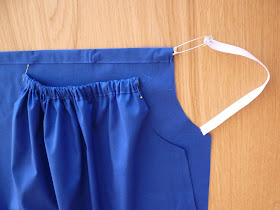This is a patternless tutorial for a tulip shaped
skirt with a fitted waistband and concealed zip to the centre back.
Step 1: Lay out your folded fabric on the table, with the
fold (selvedge to selvedge) running along the edge of the table.
Step 2: Measure your waist in inches where you want the
skirt to sit and add one inch to this number. For example a 30 inch waist will
need a 31 inch waistband. If your waist is more than 44” you will need to make
a 2 part waistband.
Step 3: Draw out a long rectangle on the fabric, 5 inches by
half your waistband measurement. For example a 31inch waistband will be 15.5
inches long on the folded fabric. Then cut this out. If you are using a light
weight fabric you might want to iron interfacing to the waistband.
Step 4: Cutting the
skirt. Decide how long you want the skirt to be, around 18 inches will come to
just above the knee. Still with the fold of the fabric on the edge of the table
draw a line a quarter of the length of your waistband, plus 8 inches for the
pleats (31” waistband = 7.75” + 8” = 15.75“.) This is the top edge of the
skirt. For the bottom edge of the skirt draw a parallel line from the top edge
with a gap the distance you decided the skirt length to be 9.5 inches long -
this should be wide enough for you to walk in the skirt without a split in the
back. Cut a second piece the same.
Step 5: Cut the centre back opening by cutting along the
halfway fold THROUGH ONE PIECE ONLY! You can do this with pinking shears, or
overlock or bind the back seams.
Step 6: French seam the skirt side seams - a French seam is
a double stitched seam, start with the wrong sides of the fabric together and
stitch a half centimetre seam, then turn the fabric to have the right sides
together and stitch a second line with a 1 centimetre seam.
Step 7: Pin the pleats. Start about 2 inches from the centre
front of the skirt and pin 4 pleats each side of the front and back, each pleat
should be about 1 inch and they should be about 2 inches apart. Turn the pleat
folds to the middle of the skirt (ie.The centre front and centre back.)
Step 8: Pin the skirt to the waistband with right sides
together.
Step 9: Sew your waistband to your skirt. Then fold the
waistband over and pin to cover the waist seam. Hand stitch this in place.
Step 10: Sew your zip. A concealed zip is best to use with
this skirt. Start by sewing the zip to the right hand edge, then fasten the zip
and mark the waist seam so you can line up waistband. Sew the other side, then
sew the back seam together. To finish fold over the tops of the zips behind the
seams.
You can hem the skirt by turning under or binding to finish.
And there you have your skirt! I would love to see photos of your skirts on,
hear your feedback and answer any questions you have.
Anna Vickery 2013 Ó













